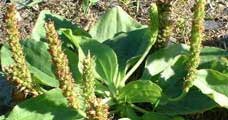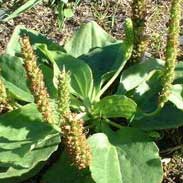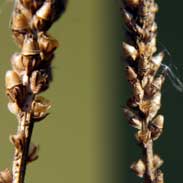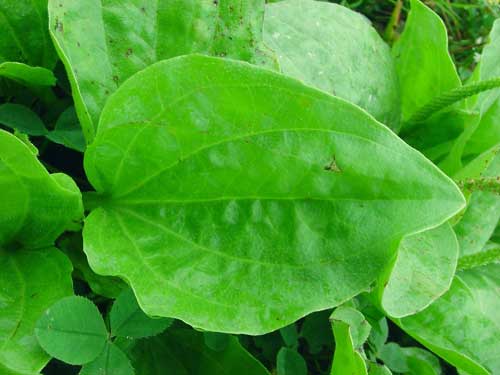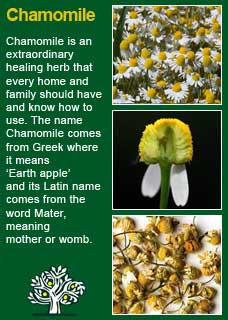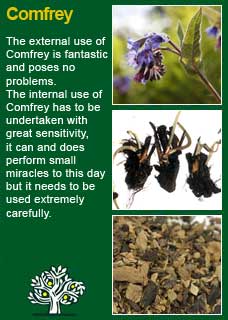
|
|
||||
| Our Pages ABOUT CONSTITUTIONAL MEDICINE
|
The leaves of a very common herb now found growing wherever people are all over the world. The American Indians called Plantain ‘white man’s footsteps’ because it followed them as they spread over the continent. The Plantain plant is low-growing, long lived (perennial) and has distinctly broad, well-ribbed oval leaves that can reach up to 12cm in length.
Plantain has a rich herbal history for use in chronic skin conditions and general weakness of the nervous system and it has been regarded as a nourishing and versatile tonic. Plantain has a tremendous folk-history as a first aid herb to use ‘on the spot’. It is highly rated for many common outdoor happenings including bites, cuts, grazes, stinging from other plants etc. The fresh plantain leaves, bruised (i.e. scrunched up enough so that its juices can run a little) is remarkably soothing and provides rapid relief for pain, itching or irritation on the skin. Internally Plantain may not be as well known by as many people but it is at least as good on the inside as it is as an external healer. Plantain has exceptional healing and soothing qualities and it can be most helpful for a damaged intestinal lining (e.g. ulcers or gastritis) or a damaged lining of the urinary tract (it was particularly favoured in the past for conditions where there was blood in the urine). Finlay Ellingwood writes 'the remedy is of value in the internal treatment of all diseases of the blood. Scrofula, syphilis, specific or non-specific glandular disease, and mercurial poisoning. It is used in ulcerations of the mucous membrane, due to depraved conditions. The British Herbal Pharmacopoeia (BHP) describes the actions of Plantain as locally 'diuretic & antihaemorrhagic' and says it is indicated for 'cystitis with haematuria & haemorrhoids with bleeding and irritation' The BHP recommends a dose of 2-4 grams of by infusion, or a 1:5 tincture in a dose of 2-4 mls up to 3 x daily and suggests it may be combined well with Comfrey for gastric haemorrhage and for haemorrhoids. D Hoffmann adds the actions of being vulnerary, expectorant, demulcent, anti-inflammatory, astringent and antimicrobial. He writes 'both greater Plantain (Plantago major) and its close relative Ribwort Plantain (Plantago lanceolata) have valuable healing properties. Plantain acts as a gentle expectorant while soothing inflamed and sore membranes, making it ideal for coughs and mild bronchitis. Its astringency is helpful in diarrhoea, haemorrhoids and cystitis accompanied by bleeding. Plantain is one of Western Herbalism's primary topical healing agents, use as a lotion, ointment, compress, or poultice for cuts and bruises' T Bartram agrees that Ribwort & Plantain have a similar action but says that Plantago major is preferred. He writes 'for chronic blood disorders, a neuralgic remedy of the first order, liquid extract or tincture is painted over painful areas of shingles etc. For irritable bowel, dysentry, bleeding piles, diverticulosis, ulcers, internal and external, internal - bleeding gastric ulcers, blood in the stool; external - lesions not healed by Comfrey'
It was called "White man's footprint" by Native Americans because it sprouted up wherever European settlers had spent any amount of time. It was also called "Soldier's herb" due to its use as a field dressing. The "waybread" mentioned in the Nine herbs charm of Wodin or Odin is believed to be plantago. Some American Indian tribes used the abundant plant as a remedy for the bite of the rattlesnake, and called it "snakeweed" after this use. The Shoshoni Indians heated the leaves and applied them in a wet dressing for wounds. Boerhaave, an 18th century botanist, recommended that Plantain leaves be bound to aching feet after long hikes to relieve pain and fatigue. The Saxons esteemed Plantain highly and in the old Lacnunga (a collection of miscellaneous medical texts, Lacnunga means 'remedies' in Old English) the Weybroed (plantain) is mentioned as one of nine sacred herbs ~ A study published in the Lancet described several people who contracted poison ivy rash who were immediately treated with Plantain; the itching subsided and did not return. ~ Plantain has several active ingredients that contribute to its medicinal action; allantoin, a substance that is well proven to stimulate tissue regeneration through causing cells to divide more vigorously (via mitosis), aucubin, a substance with proven antibiotic actions and mucilage, a soothing, natural anti-inflammatory substance. ~ The Journal of Ethnopharmacology published an article on Plantain in 2010 which states 'Scientific studies have shown that Plantain extract has a wide range of biological effects including wound healing, anti-inflammatory, analgesic (pain-relieving), antioxidant, antibiotic and immuno modulating activity' ~ The authors, titles and the 'where-and-when' published of a few further studies and articles on Plantain are listed in a PDF found here
For some years now, against this proven and safe way of herbalism, there has been a rising tide of excessive caution and scare-mongering in many parts of the world. The same authorities that, not so long ago, decried herbal medicines as ineffectual, have now taken up a different adversarial position; that they are dangerous substances that should only be prescribed by Doctors, who of course have zero training in them. Unfortunately, the same unnecessary fear and worry has crept into many natural health websites and popular publications on herbs. Herbs that we have safely used for thousands of years, that have no reports of adverse reactions in the medical literature despite widespread use by millions of people, are suddenly described as contraindicated because of something that should have been seen as completely unimportant, or at the utmost a merely theoretical concern, such as a laboratory study on one of the herb's constituents to use an all too common example. I wonder sometimes if the writers of such articles feel that the herb will be more deserving of respect if it is thought to be a little bit dangerous, in other words more like a drug than something that has simply come out of the earth and been used by ordinary people for generations beyond count. There is just so much misinformation about herbal medicine on the internet now. Ludicrous claims and cautions abound in equal measure; it seems like one group are trying to make money out of the public whilst the other are busily trying to scare them off. I have to believe that the kind of reader who takes the time to read pages on herbs that are as extensive as this one is much less likely to be swayed by marketers or misinformers. I hope that you will keep your wits about you if you get conflicting opinions from people who have never really got to know these herbs, who have never worked with them, or learned how to use them safely and effectively. I want to remind you that the reason that herbs can never be patented and owned by any individual or corporation is because they are, and always will be, the People's medicine. They belong to all of us and it is my great hope in sharing this work that you will learn how to use them wisely for yourself, and the people you care for. Be safe, but do not be afraid.
It's easy to discard a herb like Plantain just because of its very 'ordinary' nature. This would be a mistake; some of the most powerful herbs in nature have the most unassuming of shapes! It can pay to think about how these remedies earn their reputations over the long clinical trial of history.. The village doctor/herbalist in the past had no hospital to send people to...not so long ago most people lived off the land in small rural settlements, far away from the kind of concentrated populations of people that are necessary for something like a hospital to exist. Plantain earned its reputation by being able to help people with desperately dangerous conditions such as bleeding internally or externally simply because it worked. None of us can have any doubt that a herb that could avert such danger would be highly prized and that if it didn’t work it would be swiftly jettisoned! Aside from its obvious potency as a first-aid remedy I have personally come to develop great respect for its ability to heal damaged tissue from within through working with people with chronic problems. Plantain has many similarities to Comfrey with the key difference that it is very much safer to use. Many people have a ‘low-grade’ irritation and inflammation of their digestive and urinary tracts. The degree of damage to the gut or the urinary tract can vary from a little to a lot. Sometimes there will be diverse symptoms or pain, bloating and disturbed bowel or bladder function, sometimes people only know that they are much more tired than they should be and they feel that they are not getting the goodness from their food or that they have an irritated bladder with no obvious reason for it. Plantain can offer much to help heal the damaged gut or urinary system. I think that Plantain works best as a fresh herb for stings, sores, wounds of bites but then it may be best as a dried herb in tea or as a tincture as a remedy for 'wounds on the inside. A heaped tsp is about 1.2 grams, so two heaped tsps is approximately 2 and half grams and that is about the amount I would want to use in a tea form and then perhaps around 3 or 4 mls of the tincture, twice or three times a day, in combination with other herbs, to get a sure healing effect. If you who are reading this are studying herbal medicine or want to get to know this plant remedy at a much deeper level than on the abstract then I urge you to use it at the first opportunity that presents itself. Perhaps you will be outdoors (where there is grass there will be Plantain) and will get a bite from a bug or a sting from a nettle, or perhaps you will get a sudden soreness, a 'wound' in your gut, from eating something that your body takes significant offence to! In any case the rapid use of Plantain, whether it be in tea or tincture form internally, or as a plant 'bandage' to your skin, will assuredly give you an understanding of its virtue as a first-aid remedy faster than anything I could convey in writing! Plantain combines perfectly with Calendula, Yarrow, Chamomile and Agrimony to rapidly assist healing within the body when needed. I will also happily used Plantain in combination with Comfrey for external treatments or on occasion internally for short periods of time when the damage is severe and the need is great.
Much of the information here about the traditional uses of Plantain is consistent with the model of thinking whereby one may treat problem A with plant B. There is value in this approach, especially in how it helps us pass on useful knowledge to one another, but it falls short in one vital area; and that is that people are not all cut from the same cloth! Something that works brilliantly for one person may do little for another- Why is this? Part of the reason is that people vary in their constitutions as to whether they are either hotter or cooler and, at the same time, either dryer or damper. This useful and rather fascinating subject is introduced further here Another big part of using the right herb when it is most needed comes from understanding the need to treat what is going wrong for the person that had led up to their getting a health condition. In this light, Plantain can particularly offer its benefits when a nourishing action is needed in the 'cycle of healing', more about this here
Please understand that I cannot advise you, including on products or dosage, without seeing you in person in my clinic but for ideas
on how you might find a good herbalist in your area read here |
|
|
|
© 2011 R.J.Whelan Ltd
